“Light thinks it travels faster than anything but it is wrong. No matter how fast light travels, it finds the darkness has always got there first, and is waiting for it.” -Terry Pratchett
It’s the end of the week once again, and so let's have a go at another Ask Ethan! Perhaps inspired by a great giveaway, there have been so many great questions pouring in (and you can submit yours here for four more chances to win), but this week’s comes from our reader and winner Brad (you owe me your email address, Brad), who asks,
When an object is quoted as being 13.8 billion light years away is that referring to the distance of the object now, how far it was when the light left the object, or perhaps just how far the light traveled?
Due to the expansion of the universe it seems that those three distances would be quite different. Thanks!
I wish, Brad, that everyone held to the same definition. The truth is, those three distances are all different, but not everyone is consistent about what they mean when they give a distance. Let's take a simple analogy to put this in context.
 Image credit: Zack Hample of http://zackhample.mlblogs.com/.
Image credit: Zack Hample of http://zackhample.mlblogs.com/.
Imagine there are two flights of stairs, one next to the other. You stand on one, while your friend stands on the other, below you, holding a ball. Your friend throws the ball to you at a certain speed, the ball takes a certain amount of time to reach you, and if you know those two pieces of information -- the ball's speed and the amount of time it travels -- you can figure out how far away your friend is from you. Let's say, just for an example, the ball moved at 10 meters-per-second, it traveled for one second, and you and your friend were 10 meters apart. (And let's imagine the ball isn't affected by the Earth's gravity, just to keep things straightforward.)
 Image credit: anonymous Daily Mail reporter, via http://www.dailymail.co.uk/.
Image credit: anonymous Daily Mail reporter, via http://www.dailymail.co.uk/.
But I could make this problem a little bit different by, instead putting you and your friend on (stationary) flights of stairs, you could be on escalators moving in opposite directions: you moving upwards and your friend moving downwards, each at a speed of (just to pick a number) 2.5 meters-per-second.
Can we imagine that everything was the same as before? It's not so simple, and here's why.
 Image credit: Metro escalator from Prague, via http://www.landerholm.us/.
Image credit: Metro escalator from Prague, via http://www.landerholm.us/.
If your friend throws the ball at 10 meters-per-second and you start off 10 meters apart, it won't take 1 second for the ball to reach you, and you won't be 10 meters apart when the ball arrives; instead, it will take more like 1.3 seconds for the ball to arrive, and you and your friend will be separated by more like 17 meters.
If your friend throws the ball at 10 meters-per-second and you end up 10 meters apart, it won't take 1 second for the ball to reach you, and you won't have been 10 meters apart when the ball was thrown; instead, it will have taken about 0.8 seconds for the ball to arrive, and at the start, you and your friend were only separated by about 6 meters.
And if your friend threw the ball at 10 meters-per-second and the flight of the ball took exactly 1 second, that means you started off about 8 meters apart when the ball was thrown, and you're now 13 meters apart when the ball arrived. (You can put more significant figures into these numbers, if that's your prerogative; I rounded.)
The point is, when things are both separated by a distance and in motion relative to one another, it's not so simple to talk about distances, as there are three different meanings to distance:
- The distance that these two objects were apart from one another when the emitting object sent the signal that the observer will receive.
- The distance that these two objects are apart from one another when the observing object receives the signal sent by the emitter.
- Or the amount of distance that the traveling signal actually travels on its journey from the emitter to the observer.
All three of these distances were the same for the stationary (staircase) example, and all three were different for the moving (escalator) example. Well, guess which one the Universe is like?
While gravitationally bound objects -- like planets in a solar system, stars in a galaxy, or galaxies in a cluster -- might behave more like the stationary case, the vast majority of galaxies in the Universe are expanding away from one another, caught up in the Hubble expansion of the entire Universe! When we look deep into the distant Universe, we're looking deep into the past, seeing light from a time when objects were closer together, when the Universe was expanding faster, and from long ago. The major difference between space between galaxies expanding and the escalator expanding the distance between you and your friend is that while the escalator moves you both at a constant speed relative to one another, the expansion rate of the Universe changes over time!
Today, we know our Universe is 13.8 billion years old, give or take a few tens-of-millions of years. What does that mean for a distant object?
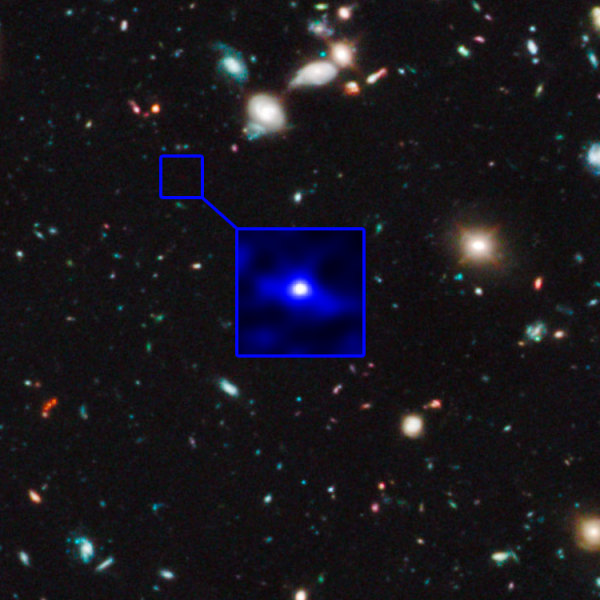 Image credit: NASA, ESA, Garth Illingworth (University of California, Santa Cruz) and Rychard Bouwens (University of California, Santa Cruz and Leiden University) and the HUDF09 Team.
Image credit: NASA, ESA, Garth Illingworth (University of California, Santa Cruz) and Rychard Bouwens (University of California, Santa Cruz and Leiden University) and the HUDF09 Team.
Consider the current record-holder for most distant galaxy in the Universe: UDFj-39546284. When we say this object is 13.42 billion light-years distant, what are we referring to?
The distance the light from it has traveled. This is -- at least to me -- a reasonable way to split the difference. In an expanding Universe, remember, the distance between objects was smaller in the past, and grows as time goes on. Even as the light travels across the Universe from the emitting object to (eventually) our eyes, the Universe continues to expand!
- This galaxy was only 1.1 billion light years distant from us when the light reaching us now was emitted.
- The light that is reaching us now was emitted when the Universe was only about 380 million years old, or just 2.7% of its current age!
- The light has been traveling for 13.4 billion years, and has traveled (by definition) 13.4 billion light-years during its journey.
- And this galaxy is now about 33 billion light-years from us at this point in time.
So, although you never know for sure which of those three numbers a journalist or writer is talking about, those are the possibilities.
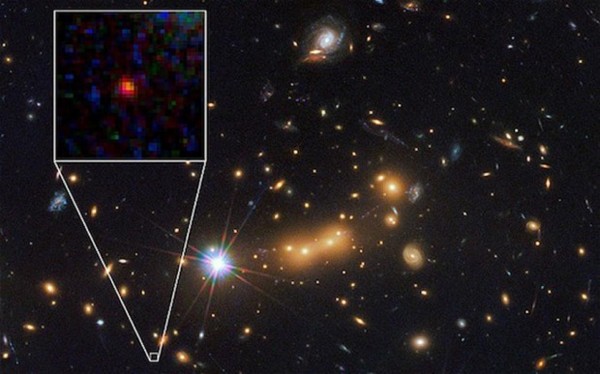 Image credit: NASA, ESA, and M. Postman and D. Coe (Space Telescope Science Institute), and the CLASH team.
Image credit: NASA, ESA, and M. Postman and D. Coe (Space Telescope Science Institute), and the CLASH team.
People typically use one of the last two methods -- either the distance the light has traveled or the distance the object is from us now -- when they talk about very distant objects. And a good rule-of-thumb is that if the distance they give (in light years) is smaller than the age of the Universe (in years), they're probably talking about light-travel-time, while if it's larger, they're probably talking about how far it is right now!
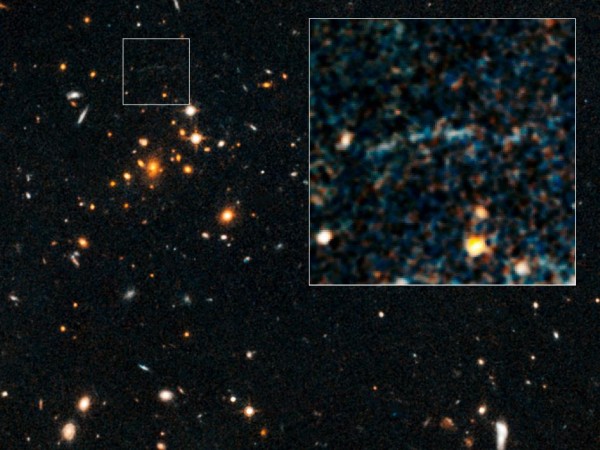 Image credit: NASA/ESA/University of Florida, Gainsville/University of Missouri-Kansas City/UC Davis.
Image credit: NASA/ESA/University of Florida, Gainsville/University of Missouri-Kansas City/UC Davis.
For closer objects -- and for gravitationally bound objects in particular -- the differences between the different interpretations are much smaller, but I'd love it if people were more careful about their words. If everyone would specify whether distances referred to when the light was emitted, how far the light traveled, or how distant the observed object is now, there would be a lot less confusion.
And that's how distances work in our expanding Universe! Brad, get in touch with me, because you won!
Got a question or suggestion for what the next Ask Ethan column should be? Let us know, and maybe you'll be the next big winner!
- Log in to post comments

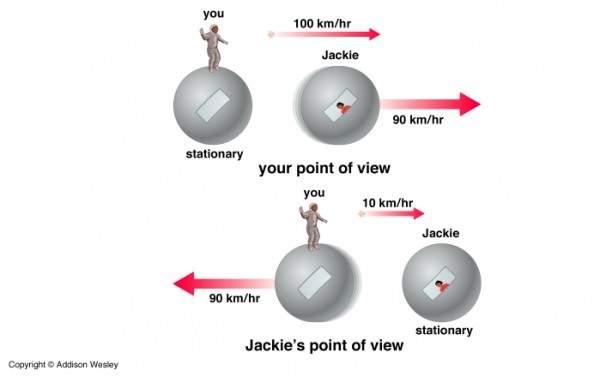
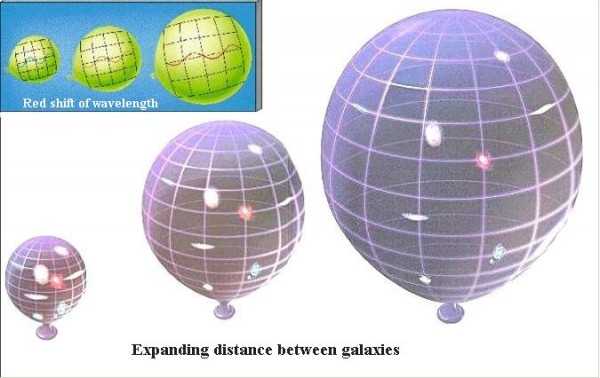

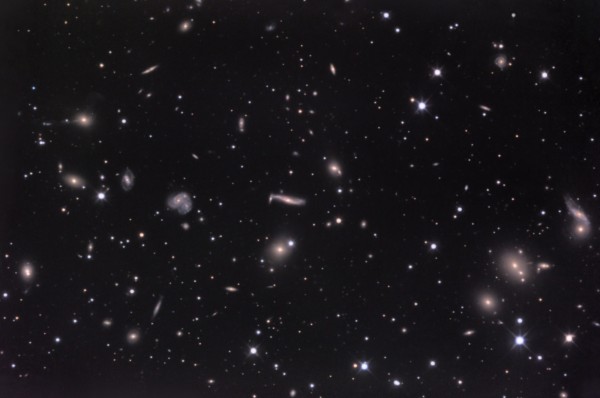
I felt a twinge of sadness when I learned how recession velocities become superluminal at great distances as a result of expansion, creating a horizon that we can never see beyond.
This horizon we can never see beyond is about 13.42 billion light years away, giving an observable sphere with a diameter of about 27 BILLION light years. What more could you want?
Geez! Some people are never satisfied.
@MandoZink #1: The recession velocity is never superluminal. It only seems that way when some yahoo does a calculation that is a linear approximation, only valid for very small redshifts :-)
For larger z (say, z > 0.5 or so), you need to use the fully relativistic calculation (see https://en.wikipedia.org/wiki/Relativistic_Doppler_effect). Rearranging some terms in the expression for 'z' on that page, you get v/c = [(1+z)^2 - 1] / [(1+z)^2 + 1].
With that expression, the CMB surface of last scattering, with z~1,100, is receding at 0.99999835c, *not* at 1,100c.
@MandoZink #1: Oh, and about that horizon. It's not a wall! As the Universe gets older, the horizon continues to expand, and things which up to now have been beyond it will come into view(*), as light has had enough time to get here from there.
(*) That would have been the textbook statement up until about 15 years ago. Because the expansion is accelerating, the horizon will eventually stop being able to expand into newly visible space, as space itself will outrun it.
You said "“Light thinks it travels faster than anything but it is wrong. No matter how fast light travels, it finds the darkness has always got there first, and is waiting for it.” -Terry Pratchett". I say only light travels in a darkness. If intensity of light is equal then light doesn't travel at all. the photons collide with each other and make more intense photons". This is copy write
It has certainly been my understanding that:
1) The most distant objects in the universe have achieved apparent superluminal recession speeds due to expansion relative to the large distances.
2) The light heading toward us that is emitted from those objects is receding at superluminal speeds and much of that will never reach us.
3) The constant expansion of the Hubble sphere will catch up with some of the light emitted, but there is a limiting horizon which will never be observable.
For a reference to this, read:
"Expanding Confusion: Common Misconceptions of Cosmological Horizons and the Superluminal Expansion of the Universe"
arXiv:astro-ph/0310808v2 13 Nov 2003
There has been much discussion of this paper in astrophysics forums and even NASA recommends this paper as a reference, with the accompanying statement:
"Some parts of the universe are outside of our horizon, and since the expansion appears to be speeding up, these will never be observable to us. "
http://imagine.gsfc.nasa.gov/docs/ask_astro/answers/061103a.html
Just Google this if you will. You will find it to be not only a highly respected and much referenced paper, but also required reading in many universities. Take a look first, then tell me what you think they have wrong.
Ethan?
"This galaxy was only 1.1 billion light years distant from us when the light reaching us now was emitted.
The light that is reaching us now was emitted when the Universe was only about 380 million years old, or just 2.7% of its current age!
The light has been traveling for 13.4 billion years, and has traveled (by definition) 13.4 billion light-years during its journey.
And this galaxy is now about 33 billion light-years from us at this point in time."
Yes if c (speed of light) is constant and there is no time dilation and no length contraction. But that is impossible.
I want to add to what I typed above at 4 AM when I got out of bed while half asleep.
In expanding space, recession velocity keeps increasing with distance. Beyond a certain distance it exceeds the speed of light. It is not a violation of relativity because recession velocity is caused by the expansion of space, not motion through space. I probably don't need to mention that expanding space stretches light waves as they propagate, adding to the Doppler shift, but I will anyhow.
The Hubble sphere (or Hubble volume) is co-moving with C, the speed of light. It's radius is 13+ billion light years. That is the NOT the current range of observable objects, however, due to cosmological expansion and when the light was emitted. That radius is now, I believe, 46+ billion light years. That is the current estimated actual distance to those objects. Most phenomena which are beyond that AND receding at superluminal velocity will never be observed. Some unobservable phenomena beyond this radius are below superluminal recession velocity and will eventually pass into the observable range. The objects beyond that will remain forever unobservable.
This is what I was heartbroken to learn - we will never be able to see it all.
( NOTE: I may need correction on the 46+ billion light year figure.)
I might now add that I somehow failed to read Ethan's figure of 33 billion light years in the article here. I thought 46+ may have been an error.
@MandoZink, various: Your reference, and your interpretation of it, was quite right. When I read your first posting, I interpreted it differently. Both of our statements are true, but they are talking about different things.
1) From your #6 (1), You're correct. When you apply the Hubble constant, or the scale factor (a-dot(t)/a(t)), which applies uniformly over the whole Universe, there is a distance beyond which the recession becomes superluminal to the observer. That distance corresponds, precisely, to _infinite_redshift (i.e., z = infinity), because it's the point at which the Lorentz factor gamma becomes 1/0.
2) From my #3: Everything for which we can receive light signals has a finite redishift -- obviously, because we can receive light signals from it, and from those signals can (in principle) extract a redshift. If you have a finite redshift, even a large one (such as z ~ 1,100 for the CMB itself), then when you apply the correct formula, you will derive a subluminal recession velocity.
All the rest of what you wrote is correct, as we understand it. The only "correction" is to your #6 (3), which I mentioned in my #4: because of the accelerated expansion, either now or in the future, the expansion itself will become faster than the growth of the Hubble sphere, and we will start to "lose objects" beyond that horizon.
@scienceblogs #7: In fact, neither the travel of light nor the cosmological expansion are affected by "time dilation." The expansion itself is measured, by definition, in the average rest frame of the Universe. Light travels at the same speed (c) in every frame, with no time dilation involved.
We can determine our own motion with respect to the cosmological rest frame. When we observe the CMB, the primary component is a _dipole_, with a higher temperature (blue shift) in one direction, and a lower temperature (red shift) in the other.
That dipole is nothing more than our own motion through the Universe, with respect to the CMB's rest frame (Ethan has previous articles discussing this).
We can use the red-blue difference to extract an actual velocity, which turns out to be about 370 km/s. That is so tiny compared to the speed of light, that our own "time dilation" relative to the CMB is negligible.
@Michael Kelsey
Some objects that are beyond the Hubble sphere, and are also receding at superluminal velocities, are still close enough that their emissions in OUR direction are sub-luminal. These particles will eventually meet up with, and cross, the expanding Hubble radius. Those are the phenomena now beyond the observable horizon which will eventually become observable in time.
That is what I meant when I said "The constant expansion of the Hubble sphere will catch up with some of the light emitted, but there is a limiting horizon which will never be observable."
@Michael Kelsey
I hope you understand that when I said " their emissions in OUR direction are sub-luminal", I was to their velocity relative to their expansion speed away from us. Light still travels at C wherever it comes from.
I apologize for my sometimes non-accurate descriptions. Good thing I don't have to teach astronomy.
@MandoZink #12, #13: Yup, quite right. We've both said the same thing, using different words. When I talked about the Hubble sphere "catching up" with objects currently beyond our horizon, that's exactly what I meant.
Also, do note the correction that as the accelerated expansion continues to accelerate, at some point in time that statement will stop being true: the distance at which we see the expansion become superluminal (i.e., "infinite redshift") will actually become closer than the Hubble horizon. This is something which hasn't been true in the past since inflation stopped, and was only recognized in the past 15 years or so, so it can be a bit confusing.
@Michael Kelsey
Could you elaborate on: "the distance at which we see the expansion become superluminal (i.e., “infinite redshift”) will actually become closer than the Hubble horizon."? What is happening there?
I do realize that you didn't literally mean mean "see" in your statement. It reminds me that my own postings habitually involve a series of addenda and errata.
@MandoZink #15: There are two different issues here (and they're jumbled up with the three different distance measures Ethan wrote about, which makes it even more confusing).
1) The "Hubble sphere" defines a maximum lookback distance for us, right now. It's just equal to the age of the universe times the speed of light: a 13.8 billion year old universe has a Hubble sphere with a radius of 13.8 billion light years. As the universe gets older, that sphere expands, at exactly one light-year per year. No matter how large the "whole Universe" (i.e., including all the stuff inflation pushed away), we can't see past that distance, because light from farther away hasn't had enough time to get to us.
2) The cosmological expansion increases the real distance between objects as a function of time.
Suppose, hypothetically, that the expansion rate was zero. Then as the Hubble sphere (1) got larger over time, we'd get to see more and more distant (and older) parts of the "whole Universe", because light from those farther away places would have time to reach us.
But the expansion rate is finite, not zero. So, as you know, there is some distance at which we "would see" (if we could) an infinite redshift, corresponding to "superluminal" recession. Right now, the expansion rate is low, so that distance is larger than the Hubble sphere.
But we now know that the expansion rate is increasing (accelerating). In the future, the expansion rate will be fast enough that the "infinite redshift" distance will approach, and even be smaller than, the radius of the Hubble sphere.
At that point, the farthest/oldest objects we could conceivably see in the Universe will be younger (eventually much younger) than the age of the Universe at that time.
When in the future this happens depends on the details of the accelerated expansion.
There's another interesting implication of the expansion of the universe and contraction of the Hubble sphere:
Today, right now, we are collecting astronomical data that will not be directly accessible to humans at some point in the distant future.
Thus we owe it to our distant descendants to a) collect as much data as we can and b) develop the means to preserve the data we collect in ways that remain accessible over extremely long spans of time (millions to billions of years). The latter will entail continually copying data to new storage media as technology evolves, and translating language and mathematics as needed to stay current; these tasks can almost certainly be automated.
This is another part of the "sustainability/science/space" value system, whereby the actions we take or fail to take today, have very real impacts on those who will come long after us.
Question: how far into the future will we start to lose a significant fraction of what we can presently observe? For example today we can see events that occurred in the early universe immediately after the Big Bang: how long will it be until the objects of those events are no longer visible? How long will it be until objects/events from the early epochs of the universe are no longer visible?
(And yes I do think it's worthwhile to be concerned with humanity and its descendants millions of years into the future: thinking here about the capacity for space travel, space defense against large object impacts in inhabited star systems, becoming an interplanetary and interstellar species, and so on: all long-term endeavors related to the central purposes of preserving the lineage of Earth-originated life and building an unbroken progression of knowledge of the universe.)
G, the visibility of the early universe is a bit four-dimensional, really. Not very intuitive.
There will always be a connection between us and some photon from the big bang period. The time-line will always connect us. Because we have that in our past.
However, it will shift further and further into the radio wave area and be pretty much invisibly faint.
However, a time-line between us and, say, the Virgo Super Cluster, does not always have to connect. It and us were never in the same event position in the past, therefore a connection between us can be broken.
It would be safe to say that well before that happens, there would be no Milky Way.
@Michael Kelsey
Got it. Thanks. I've followed a lot of the speculation and musings as to the eventuality of the expansion.
Whether it be a Big Freeze or a Big Rip, I like to think that some configuration of emerged sentience will have evolved before then into an entity we humans probably could not conceive of. Optimism from a non-theist.
@Wow #19: You're quite right, on both counts. The "surface of last scattering", since it happened "everywhere", should be visible even as the expansion accelerates. Condensed objects, however, can recede beyond the Hubble sphere once the expansion rate is high enough.
I'm not entirely sure that your guess about when is really correct. We don't have any firm upper limit on how long a single galaxy may persist, though the data on virial velocities in ellipticals suggests (I think) that they have indefinite lifetimes.
I didn't find a clear reference for any such calculation; the best I got was a 2005 paper showing that so-called "grand design" spiral galaxies (like the Whirlpool) are fairly transient. Maintaining the pattern requires a uniform angular velocity, which is not supported by observations.
Well, unless you count white dwarf remnants and brown dwarves as suitable for considering as a galaxy, the Milky Way won't last more than a trillion years, and an expansion taking the Virgo Supercluster beyond our horizon is unlikely unless there's a phase change "inflation" period between now and then.
A few hundred trillion years may not be long enough.
I'd hardly call it "calculation", never mind "firm upper limit" to give a 100-fold fiddle figure for an age of a galaxy..!
"This galaxy was only 1.1 billion light years distant from us when the light reaching us now was emitted. [...] The light has been traveling for 13.4 billion years, and has traveled (by definition) 13.4 billion light-years during its journey. And this galaxy is now about 33 billion light-years from us at this point in time."
So right now this galaxy is beyond the Hubble sphere & thus we will never see the light it (presumably) is currently emitting. We will continue to receive its much-delayed "baby pictures" for a while longer, but the redshift of those images will become infinite within a few billion years. So only the early part of that galaxy's lifecycle will ever be visible to us because that part happened before the expansion of space pushed that galaxy past the boundary of the Hubble sphere. Correct?
That which was 1.2 billion light years from us at that time are not and, because of inflation, never will come within visible range of us.
Absent inflation, they would.
PS Remember: we are the result of the same universe's evolution, just like that galaxy that lies beyond our sight.
Intriguing discussion. Although the science content of this discussion is of great interest to me, I will make a comment below which is more philosophical in nature.
Much of the discussion centers around time measurements. Interesting that before the big bang (if that is your preferred theory of how the universe began) most scientists assume time did not exist. So what caused all this to come about (perhaps in the absence of time) so that we could now share this fascinating discussion (in the presence of time)? Seems there are at least three explanations:
1) Our universe has "always" existed.
2) Universe came into existence all by itself.
3) Universe was created (when time began) by an existing intelligence.
Of course a few reach for other possibilites, like infinite parallel universes and equilibrium theories. But assigning initial probabilities of about 1/3 to each of the three above, what do we do with that, knowing that our universe (and we) appear to be headed toward an ultimate cold, dark and uninteresting death?
As a theist, I adjust the initial probability weights based on:
1) The observed astounding fine tuning of our universe physical constants.
2) The extreme improbability of developing functioning life DNA and proteins (during only a few billion years).
3) The phenomenon of human consciousness, which we inherently recognize even before we conclude the existence of matter and energy. Personally I then wind up with at least a 99% chance of possibility #3, and live my life accordingly.
FYI, I am a Ph.D. engineer (not a scientist) who in later life has become less interested in engineering and more in science and philosophy. If you find my comments interesting, good. If not, you can ignore them (or disagree with or ridicule them).
So the light from that furthest away galaxy that is 13 billion ly away that we see now is actually about 33 billion light-years from us at this point in time and is nothing but dust and cinders. Correct?
Or a black hole?
33 billion light years, and moving away? And it's going somewhere? In something? Are you seeing an edge ahead of it? Maybe there is no edge, maybe the universe just goes on forever.
1) Our universe has “always” existed.
2) Universe came into existence all by itself.
3) Universe was created (when time began) by an existing intelligence.
3a) Which has "always" existed
3b) Which came int existence all by itself
3c) Was created by an existing intelligence.
3ca) Which has "always" existed
3cb) Which came int existence all by itself
3cc) Was created by an existing intelligence.
.
.
.
"1) The observed astounding fine tuning of our universe physical constants."
Ever wondered at the AMAZING design that goes into a puddle?
Always has a precise and good fit to that fractally complex shape!
Why do so many engineers belive in the foolishness of a.designer? And why do they think saying "I am an engineer" makes them sound less foolish?
Wow - Thank you for clarifying my possibility 3. Your logical response (as opposed to an ad hominem attack) is appreciated and informative. You are absolutely right that the same possibilites can be considered for the origin of the existing intelligence. Quite a conundrum, isn't it? That's partly why I allowed "initial" equal probabilites of 1/3 to each possibility, because anyone can ask the obvious question "Who designed the designer"? Seems we are left with the somewhat mind-blowing conclusion that SOMETHING (either the universe or the intelligence) likely has "always" existed. And from that, and the evidence I listed, is where I have drawn my "final" conclusion to thesim. I would be curious to know your final conclusion, and why? Or are you one of those interesting and uncommitted agnostics I especially enjoy and respect in discussions? BTW, your comment about the universe physical constants sounds very much like the anthropic principle (i.e. we shouldn't be surprised by the extreme improbability of our universe fine tuning, because if it hadn't happened we wouldn't even be here to think about it). That is a whole other (but interesting in itself) discussion.
dean - Thanks also for your question. I wasn't aware that so many engineers, in particular, believe in "the foolishnes of a designer." I have a philosophically astute engineer friend who is an atheist. I suppose I am a simple and perhaps foolish person, but I only related my background because I've found that knowing a person's background often helps to understand him/her better.
Two well-written books I especially like are atheist Stephen Hawking's "A Brief History of Time" and ID enthusiast Stephen Meyer's "Signature in the Cell."
On the initial topic, of course "light year" is a mixture of time and distance concepts. I remember my surprise when this engineer learned many years ago that the progression of "time" is not an absolute, but somewhat depends on the observer's velocity. I've rationalized that time is really a progression in our consciousness related to comprehended changes in the state of matter and energy. For what's it's worth, as a simple engineer, a reasonable description of distance between objects A and B (at a given time) is the observed time it would take light to travel between them if A and B both had stationary zero velocity. I guess that ignores some interesting things that can happen to light on the pathway.
"Quite a conundrum, isn’t it? "
Since the third option does not actually do any answering that makes complicating the situation any better, why do it?
Conundrum solved!
"God" == "I don't know", but without the intellectual honesty of admission.
Worse, without the option of changing your mind. After all, if you've already "answered" it, why look?
THIS is why "GODDIDIT!" is anti-science.
"And from that, and the evidence I listed, is where I have drawn my “final” conclusion to thesim. I would be curious to know your final conclusion"
I conclude that my language cannot say the answer. I do not pretend to have answered it with the non-answer of theism. I will not abrogate my responsibility to answer just because it's hard.
But it is proven, absolutely PROVEN that matter can be created from nothing and NOT ONE IOTA OF GOD is needed.
Therefore you have to look for another reason for your god to exist.
Because there's no need for one to make a universe.
dean: "Why do so many engineers belive in the foolishness of a.designer?"
Because they only look at things via a design mindset. "How can I do this?" not "Why does this work?".
I rather think, though, that the causality is reversed. Those who would otherwise be of a scientific bent but would much prefer the pale blue comfort blankie of their specific and minority religion will go into engineering because that doesn't cause the pain of re-evaluation of their worldview.
"On the initial topic, of course “light year” is a mixture of time and distance concepts."
No, spacetime is a mixture of time and distance concepts.
Light year is no more a mix than "It's four days march to the next town" by the Roman Legion commander means the distance from Dover to London is a mix of time and distance.
Wow: I will take under consideration your opinion that I (and others) became engineers because they "prefer the pale blue comfort blankie of their specific and minority religion" which "doesn't cause the pain of re-evaluation of their worldview." Perhaps you are right, although I had never thought of that before. I thought I went into engineering because I loved mathematics and the ideas of understanding principles and building things.
Back to the original topic, I called "light year" a mixture of time and distance concepts, because a) it is intended to be a measure of "distance," and b) it involves a "time" i.e. a year. Sorry if my engineering understanding is lacking there.
As a simple engineer, not really up to speed on some of the intricacies that you may understand, I have found the following example (although extreme and impractical) to be intriguing. Suppose you watched me move into space at the speed of light, traveling for one year. I then reversed course and came back, again traveling at the speed of light. In your time frame, I would have been gone two years. In my time frame, I would have been gone for zero time (and I would have no more gray hairs, which is a good thing). Of course, the relative (velocity dependent) nature of time has been verified by atomic clocks incorporated into spacecraft.
So what really is "time"? Again, I look at time as "a progression in our consciousness related to comprehended changes in the state of matter and energy." Forgive my complexity here, perhaps you can define time in simpler terms.
Since time is so relative, it is also easy for me to view the Designer as operating outside of time. I think of human beings (and all of the universe) like the information in a symphony. For the symphony to play, it is put onto a physical medium (like a CD). Matter is currently used as the medium for expressing the information. If the matter in a human being, or the universe, disintegrates (unfortunately that seems to be gradually happening to me), the information symphony is not destroyed. The Composer is quite capable of transferring that information onto a new and better medium. Yes, we engineers can get a bit philosophical, but I understand that many scientists are more involved in the "philosphy of science" than we are.
"I thought I went into engineering because I loved mathematics and the ideas of understanding principles and building things."
Ever thought that you got that wrong? I didn't say that you didn't go into it for the pale blue blanket but that you avoided physics which HAS mathematics, the ideas of understanding principles and involves as much building as an engineering course because you wanted to keep your pale blue blanket.
Maybe you need to stop reading, 'cos you frankly are piss at it.
"Suppose you watched me move into space at the speed of light, traveling for one year. I then reversed course and came back, again traveling at the speed of light."
You'd have to be massless.
"I then reversed course and came back, again traveling at the speed of light. In your time frame, I would have been gone two years. In my time frame, I would have been gone for zero time "
Uh, what the hell does this have to do with your earlier post? Is that the post being moved again?!?
A light year you posited as a combination of space and time.
Your idea here has NAFF ALL to do with showing or analogising that.
If you travelled in an orbit around the earth at light speed for two years of my time, you'd never get a light year away, but you still would find a two year discrepancy between our assertions of elapsed personal time.
"Since time is so relative, it is also easy for me to view the Designer as operating outside of time."
But this thread has bugger all to do with myths. Either leave it for another blog or post here where you will at least not be cluttering up science threads with mythology:
http://scienceblogs.com/startswithabang/2012/09/23/weekend-diversion-yo…
Angry and crude language is unfortunately sometimes substituted when knowledge and logic are inadequate.
My congratulations to Ethan Siegel for an important and insightful article, and to many who made valuable comments. An accurate common understanding of distance and time concepts is a key to greater power in clearly communicating and advancing science of the universe. This article deserves a wider distribution.
Another book I recommend is George Guilder’s “Knowledge and Power.” It provides great insight into information and communication sciences, and how they have supported the huge advancements in larger science and technology of the last half century.
So you're still bullshitting about and think that only rude words define impolite, but shitting all over Ethan's blog is not?
Why the fuck should I give one solitary fuck in a lonely universe what you think of me?
You don't even think yourself.
Is it true that some objects are blue shifted? If so, how?
Is it true that some objects are blue shifted? If so, how?
Gravity is causing objects to collapse toward one another faster than the local expansion of the space between them.